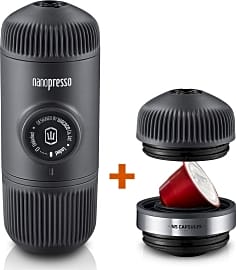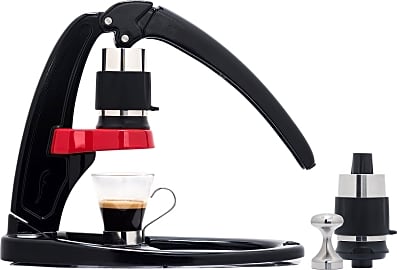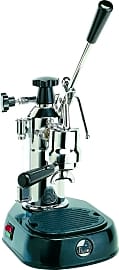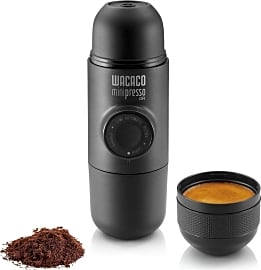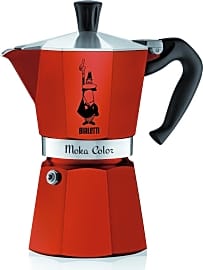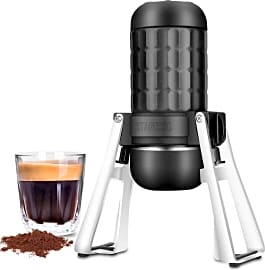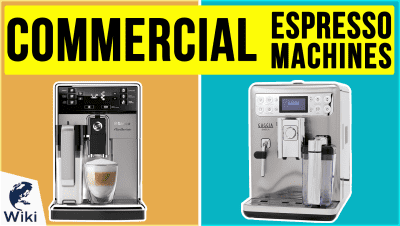The 9 Best Manual Espresso Machines

This wiki has been updated 42 times since it was first published in October of 2016. For those who like to make their java with a touch of old school charm, we present these manual espresso machines. We've included some nifty portable models that don't require any electricity, so you can take them camping, through to deluxe countertop designs that would not look out of place in a traditional Italian cafe. They are available in options to suit every budget, too. When users buy our independently chosen editorial choices, we may earn commissions to help fund the Wiki.
Editor's Notes
July 16, 2021:
Naturally, few of these will work quite as well as a commercial machine does, but they're generally far less expensive, take up a lot less space, and make virtually no noise compare to bulky, electric espresso machines. With that said, the La Pavoni PC-16 is the rare manual model that does produce significant crema, a defining characteristic of great espresso. The Flair Signature Kit is probably the most straightforward and easiest to use, while the Wacaco Nanopresso is perfect for making ultra-strong coffee on the go. It's also worth noting that there was no need for us to update any of the rankings today.
March 25, 2020:
For true coffee aficionados, few things are more rewarding than a perfectly brewed espresso. Unfortunately, it can be rather difficult to find a place that serves one and automatic machines are generally very pricey. Luckily, these manual espresso makers can help with that. Most are very affordable, and all are easy to use.
If you are looking for a professional-quality model that can stand up to the rigors of commercial use and allows you to make cup after cup, with little downtime in between, the La Pavoni PC-16 is going to be your best bet. It features an integrated heater, so you won't have to boil the water elsewhere and pour it inside, and has a 32-ounce reservoir, allowing you to make up to 16 two-ounce shots in a row. The La Pavoni EPBB-8 Europiccola offers the same commercial build quality, but in a slightly smaller and more affordable model. However, its smaller reservoir means it can only make eight shots in a row.
Those who prefer something very traditional may want to consider the Bialetti Moka. Mokas have been a staple in Italian homes since they were first invented in 1933. While there can be some debate over whether they produce a true espresso or not — they certainly don't create as much crema as some may like — there is no question that they are affordable, easy to use, and produce a fantastic cuppa.
For those who need something portable, perhaps to take camping or keep in their desk drawer at work, we have included a few handheld models that will do the trick. These include the Wacaco Nanopresso, Wacaco Minipresso GR, Moocoo Hand-Powered, Staresso 3rd Generation, and Handpresso Wild Hybrid. It is worth noting that while these don't require any electricity, they do require you to pour already hot water into them, so you'll need to have some method to boil it externally, such as a campfire or microwave. We think the Handpresso Wild Hybrid is probably the least convenient, as it doesn't have an integrated serving cup, meaning there will be one more thing to remember to carry along if taking to the great outdoors, but we do like its built-in pressure gauge.
Special Honors
Kamira Moka Express The Kamira Moka Express sits on your gas or electric stovetop, or even a hot plate, to heat the water and build up the pressure needed to pull a shot. It is handmade in Italy, where they know a thing or two about making a great espresso, and is backed by a five-year warranty. espressokamira.net
Rok Presso The attractive Rok Presso is crafted from polished metal and features a visually interesting, two-arm frame that makes it easy to control the brewing pressure. The newest model is built with a high-quality piston gasket that ensure it never leaks pressure, and it is equipped with a removable dispensing spout for convenient cleaning. rok.coffee
What Is The Difference Between Automated And Manual Espresso Machines?
The pumps in standard espresso machines may break after continuous use.
Though automated and manual espresso machines are very similar, there is one distinct difference that can easily tilt a user towards choosing one over the other. Simply put, automated machines do all the work for you. On the other hand, they may cause more work in the long run. Manual espresso machines tend to last much longer than automated espresso machines. A manual espresso machine contains fewer components than a standard electrical machine. A greater number of components usually means more to clean and more possible reasons for a machine to stop working. The pumps in standard espresso machines may break after continuous use. The buildup of hard water minerals in the machine often causes clogged pumps and tubes. Altered tubes also change the extraction pressure as they become more constricted. This process will degrade the quality of the brew and put undue stress on the pump, as well — contributing to further breakages.
Manual espresso machines typically only contain the basic components needed to make espresso. The water reservoir stores either cool or heated water before it comes into contact with the coffee grounds. Some manual espresso machines have a heating element within the reservoir. Other machines rely on an outside heat source to boil water, such as a stove or campfire. All espresso machines contain some sort of portafilter that the coffee sits in during use. Portafilters have very small holes on one side that allow the espresso to flow during the extraction, while holding the thicker grounds back.
Some manual espresso machines contain a pressure gauge, while others require you to gauge the perfect pressure by feel. The learning curve of most manual espresso machines lies here. Some manual machines create the ideal nine bars of pressure quite easily. At nine bars, it'll take you between 25-30 seconds to pull one shot of espresso. It takes more time to pull a shot using less pressure, and less time to pull a shot using more pressure. Some people find that they prefer using varying levels of pressure and time to create their desired brew. It is all about finding what your taste buds love. Espresso is a personal art, and manual espresso machines help people find their own personal expression in that art.
Benefits Of Espresso
Many people drink espresso to energize them for the day ahead. While espresso has started earning a bad reputation in the health community, that is actually undeserved. Espresso is much healthier than it is given credit for. One serving of espresso is very low in calories, and is loaded with beneficial nutrients like vitamin B2, vitamin B3, and magnesium. Espresso is also a good source of potassium, iron, and healthy fats. Of course, it is most known for its liberal caffeine content.
This uptick in attention can actually lead to improvements in long term memory.
The caffeine in espresso can help to improve attention. This is fairly obvious, as alertness is often cited as a reason people drink espresso. This uptick in attention can actually lead to improvements in long term memory. A study posted to the journal Nature found that drinking espresso after studying improved a person’s ability to remember the information they studied for longer periods of time. This means a manual espresso machine may be the perfect gift for college-bound students. Espresso may also have a connection to lower levels of certain cancers. Researchers recently found that people who drink a lot of coffee have a reduced risk of aggressive prostate cancer. Espresso is also good for the liver, it boosts physical performance, and may even prevent cavities. It also supports weight loss by boosting the metabolism and improving digestion.
It is very likely that the things we add to our espresso cause the health risks associated with coffee consumption. Milk, cream, sugar, and flavored syrups may all contribute to various health risks. For example, sugar sweetened beverages contribute to higher rates of obesity and other disorders, like metabolic syndrome and Type 2 diabetes.
Drinking too much espresso may still pose some risks, though. Extremely high levels of caffeine can cause symptoms of agitation, jitters, heart palpitations, and anxiety. The body of someone who regularly drinks too much caffeine will often go through withdrawals when they stop drinking it. That said, enjoying one or two cups of espresso from a manual espresso machine may be a great step towards keeping a person energized in the short term while boosting their health in the long term.
History Of The Manual Espresso Machine
While we know now that regularly drinking espresso seems to reduce the risk of mortality, this isn't why people started drinking it. Legend has it that the shepherd Kaldi discovered coffee after his goats became energized from eating the beans, and he simply wanted their energy. Coffee cultivation started and thrived on the Arabian Peninsula, and it was not long until people were looking for new ways to prepare the beans for consumption. Public coffee houses began to spring up, and the craze quickly swept Europe early in the 17th century.
Moriondo technically provided the first espresso machine, but it was Luigi Bezzara and Desiderio Pavoni who created the first true espresso machine.
The first espresso machine would arrive over 200 years later, thanks to a man named Angelo Moriondo. His machine harnessed steam to extract coffee from the beans, but it was essentially just a large-batch coffee maker. Moriondo technically provided the first espresso machine, but it was Luigi Bezzara and Desiderio Pavoni who created the first true espresso machine. Bezzera’s coffee making machine included nearly everything a modern espresso maker has. Pavoni helped him improve the idea, and together they created the first single-serve manual espresso machines the world had ever known. The problem with these machines was pressure. No one could brew espresso past two atmospheres of pressure without giving the beans a completely scorched taste.
Manual espresso machines as we know them today did not arrive until after World War II. Gaggia’s lever machine used steam pressure from the boiler to force water into a cylinder that would pressurize it even further. Pulling the spring-piston lever released the water into the puck at up to 10 bars of pressure. This was the realization of true espresso. It is also where we get the term pulling a shot of espresso.


